[ad_1]
This post may contain affiliate links. We may receive a small commission, at no cost to you, if you make a purchase. Read Disclosure.
Lace up your boots adventure seekers, it’s time to climb to one of the best viewpoints in the Peloponnese region of Southern Greece: Palamidi Fortress in Nafplio.
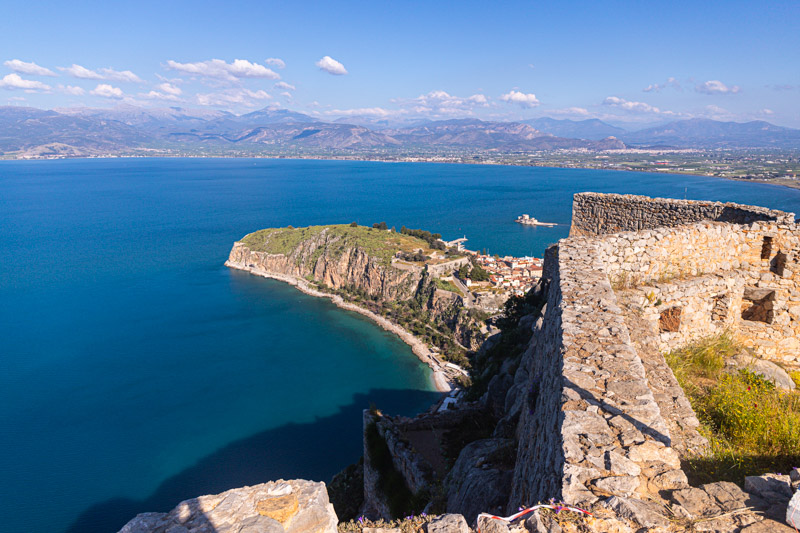
Perched high on a hill overlooking the Old Town on the edge of the Argolic Gulf in the Aegean Sea is the Palamidi Castle. Its expansive view was the reason for this strategic location as the city of Nafplio was an important maritime city at the time.
Its purpose now is to give you Facebook envy material for your friends back home! #wishyouwerehere
I spent three nights in Nafplio on my Peloponnese road trip. Climbing the 999 steps to this ancient fort overlooking what was the first capital of Greece was one of my favorite attractions in Nafplio.
If you’re ready to conquer the heights and soak up significant modern Greek history, stunning views, and a whole lot of fun, keep reading to find out how…
Why climb 999 Steps to the Palamidi Fortress?
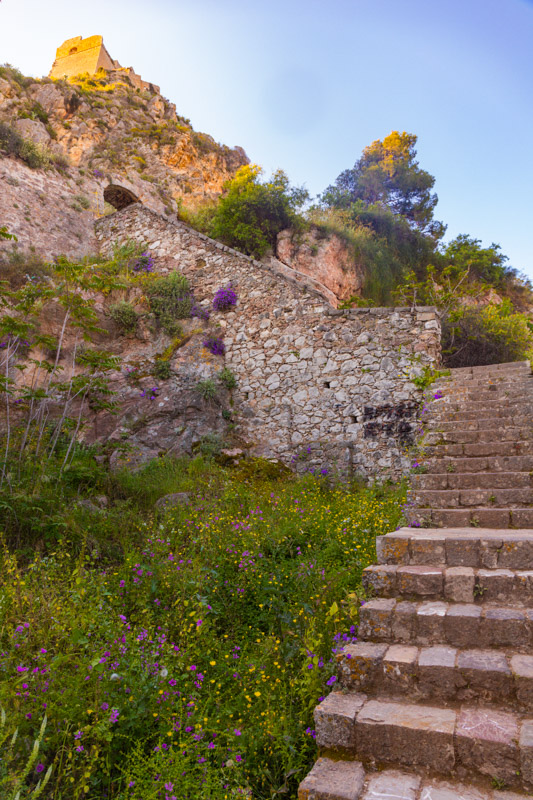
Aside from the breathtaking panoramic views, Palamidi Fortress offers a captivating journey into Greek history and culture.
It’s an opportunity to immerse yourself in the stories of the past, feel the weight of the battles fought, and admire the true architectural masterpiece of the Venetians.
Plus, the sense of accomplishment you’ll feel when you reach the summit is a win.
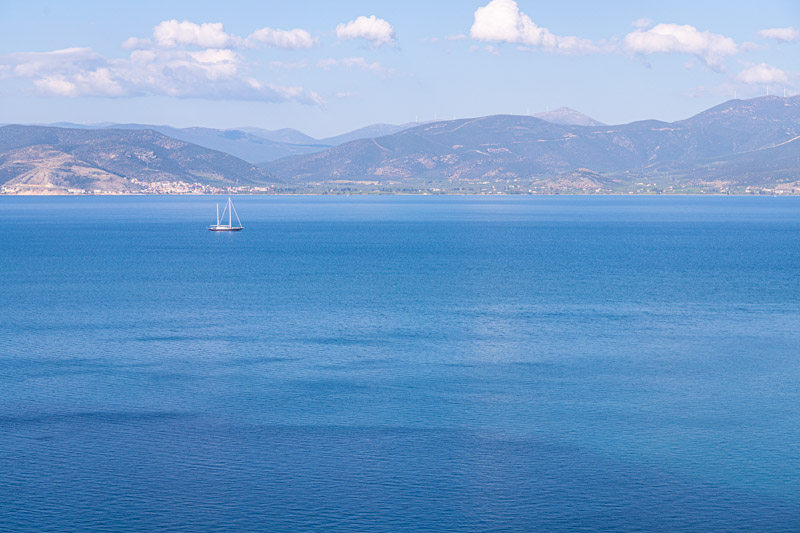
Fun Fact: It is widely reported that there are 999 steps, but it’s “only” 857 – but I also have heard other numbers too!! Perhaps count and see. It may take your mind off the climb! (It’s not that bad)
If you go all the way to the top of the fortress once inside, you’ll climb over 1,000 steps.
How long does it take to climb Palamidi?
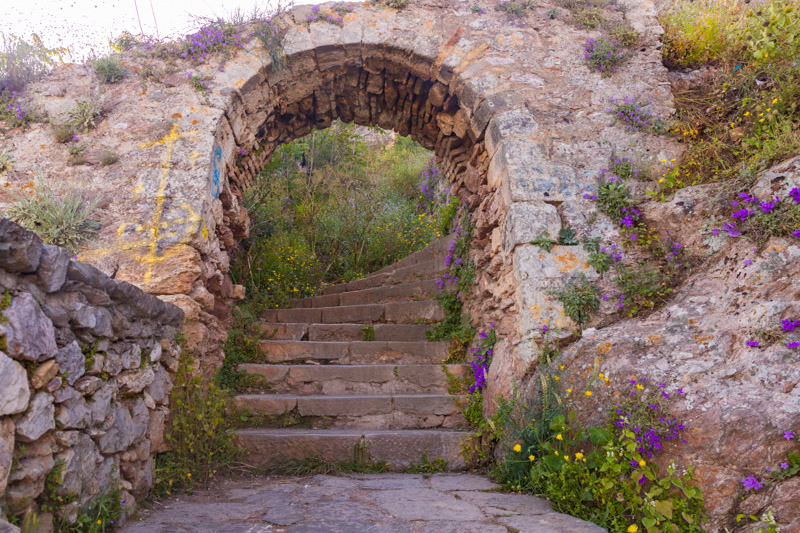
Honestly, these 999, or 857 steps, are not that bad. Don’t let that number scare you.
There are plenty of places you can pull over and rest along the way with a spectacular view to keep you company. Let me warn you, the views only get better the higher you go up.
And let’s face it, going up the winding stairs will help you imagine you’re a Greek revolutionary hero leading the surprise attack to start the first nation of Greece!
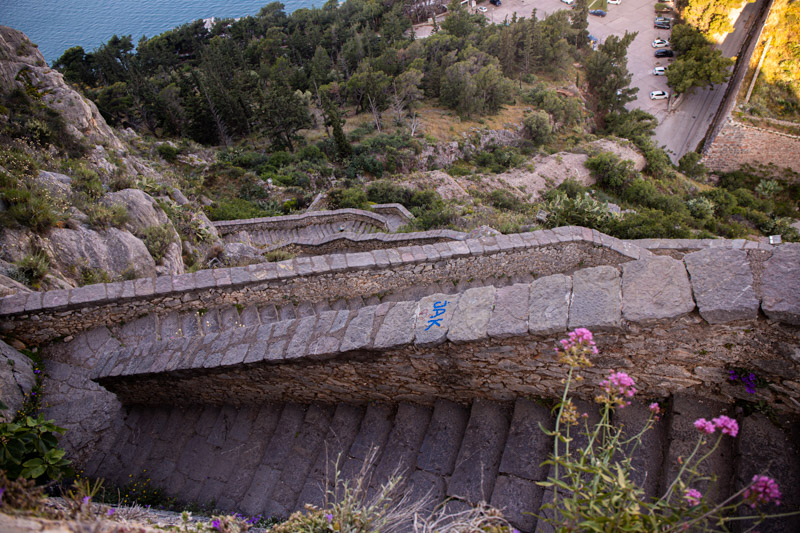
The key is to start early in the morning when the shadow covers the stairs. I arrived just after 8am and almost had the entire place to myself. The Palamidi Fortress can get busy, especially when the tour buses come in, so beat that rush with an early start.
Also, with the positioning of the sun in the morning, this is the best time to have perfect light shining on the Argolic Gulf for an impressive view and photos.
The path is a little uneven in some places so wear sturdy shoes with a good grip for the stone stairs.
A Brief History of Palamidi Fortress
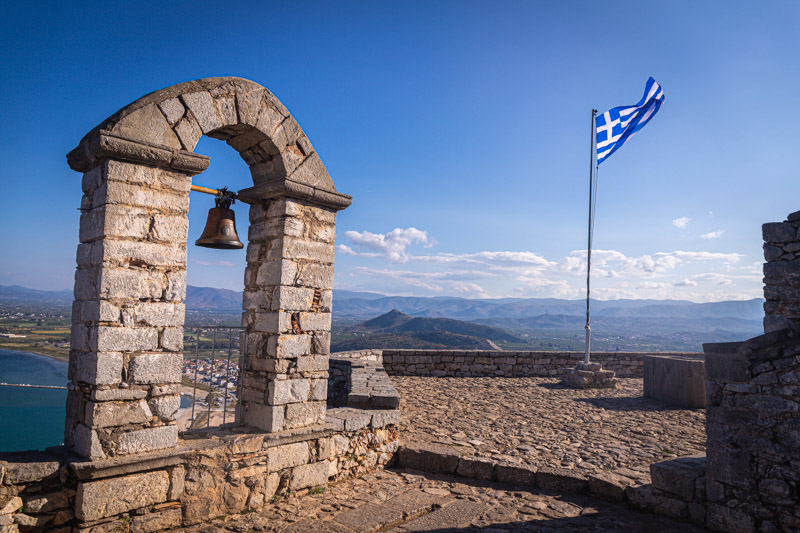
The Palamidi Fortress is yet another ruin on the Peloponnese that stands as a testament to Greece’s rich past, and is arguably the finest sample of the Venetian Fortifications in the area..
It’s a typical baroque fortress made up of eight small battlements and bastions, that was named after Palamedes, the mythical hero of the Trojan War.
So you can imagine it’s all about defense and strategy.
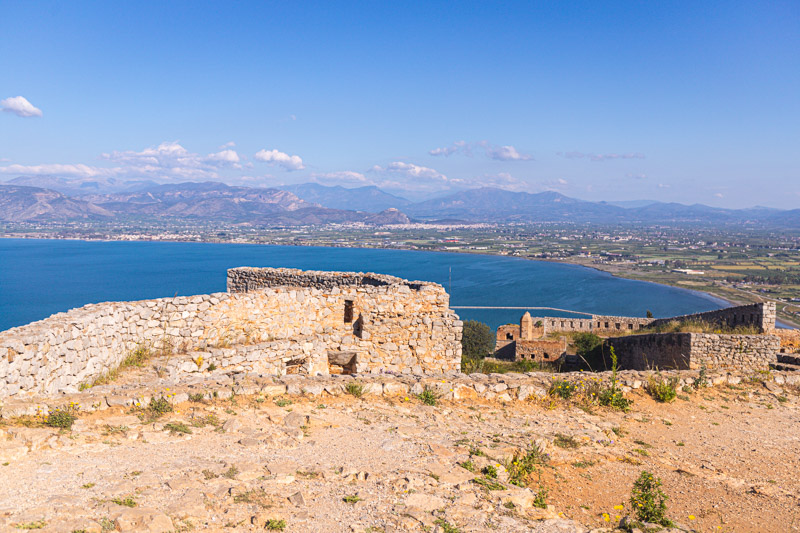
Built by the Venetians during their second occupation of the area in at the beginning of the 18th century, in an amazingly brief time frame between 1711 and 1714, this 216m high fortress served as a stronghold to protect Nafplio against enemy invasion.
It was the final important Venetian defensive structure in the area and is considered the most impressive.
Their revelry in their accomplishment was only for a relatively short period, in 1715, the Turks attacked the Venetian occupation, and defeated them.
From here, the castle belonged to the Ottoman Empire and Ottoman rule of the region began.
Since then, the fortress witnessed significant military action.
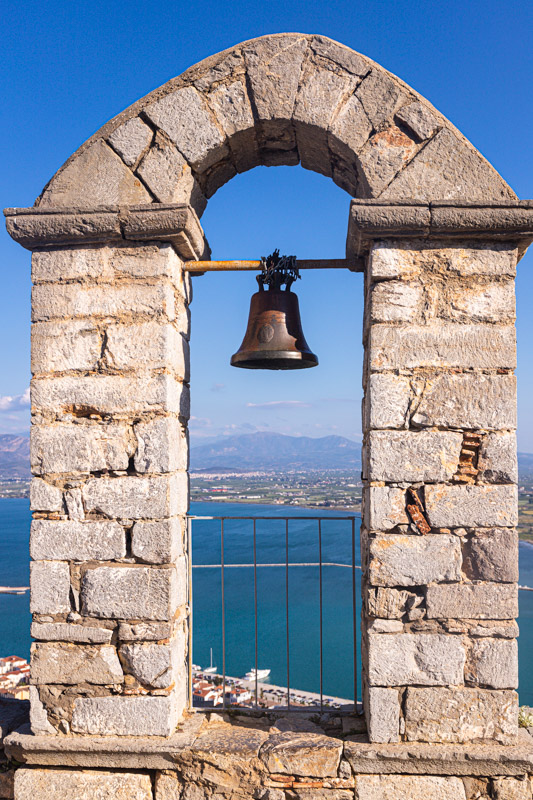
During the Greek War of Independence in the early 19th century and on November 29th, 1822, a group of Greek rebels, led by Staikos Staikopoulos overpowered the Turks in Palamidi.
Nafplio became one of the first places in Greece that won independence and soon after it became the first capital of Greece.
Palamidi then became one of the toughest prisons in Greece. It is rumored that the leaders of the revolution and hero Theodoros Kolokotronis was imprisoned here for some time after being charged with treason after a serious conflict with the Regents.
Although he was sentenced to death, he received a royal pardon and became an “Advisor of the Country,” after Otto’s coming of age.
How to Visit Palamidi Castle
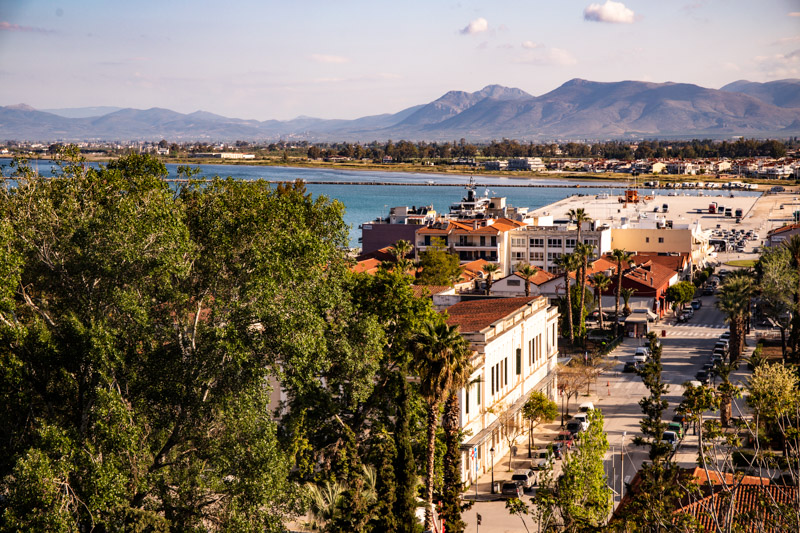
First things first, lace up your comfiest walking shoes because, as mentioned, reaching Palamidi Fortress requires a bit of a climb. You have two options: the long stairway or the short drive up the road.
For those who want a bit of a challenge and a heart-pumping workout, take the (not really) 999 steps leading to the fortress.
But if you prefer a more leisurely approach, follow the road that winds its way up the high hill.
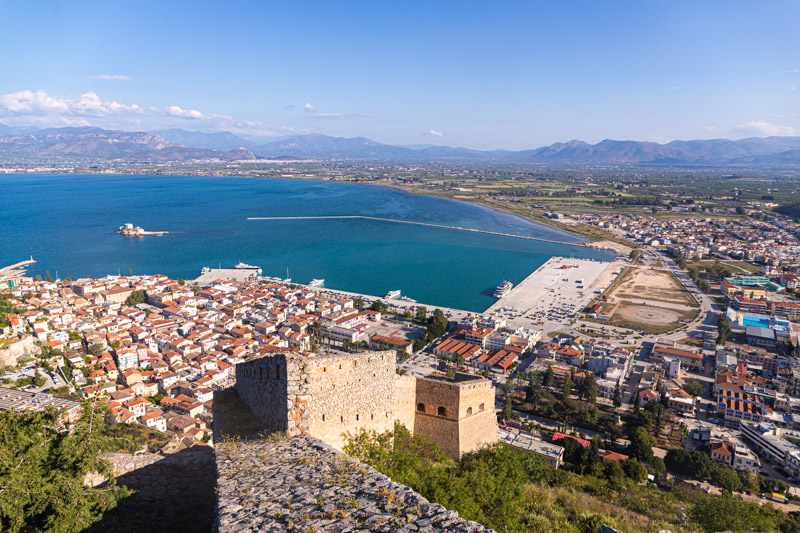
For those really opposed to walking, you can also drive up that road and park at the gates on that side of the fortress. May tour groups arrive that way.
The steps begin on the edge of Old Town at the bottom of the hill. It took me five minutes from my Nafplio Hotel to reach it.
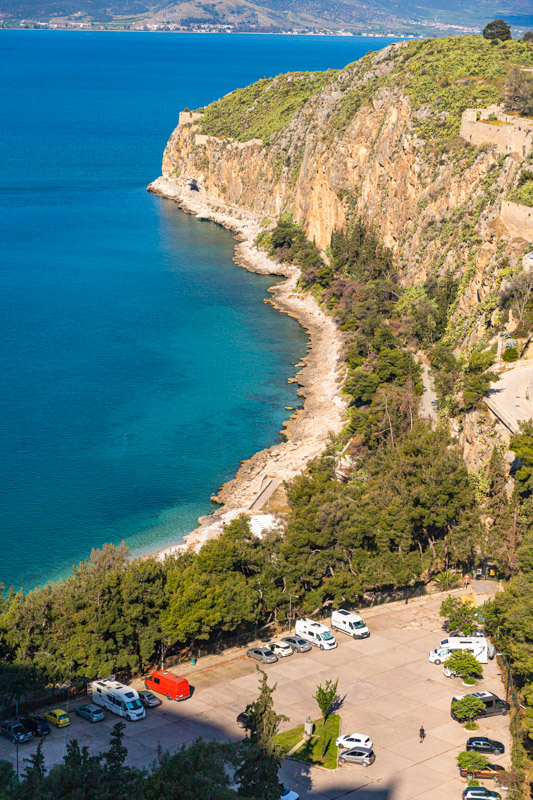
There is also a parking lot between the bottom of the Hill of Palamidi and Acronafplia (the hill opposite Palamidi which also has ruins of an old fortress. More on that below) The parking lot is also above the beautiful old town Beach, Paralia Arvanitias.
Whichever route you choose, make sure to bring plenty of water, sunscreen, your camera, and a happy, adventurous spirit.
You’ll only need 1-2 hours to explore the fortress, including the climb up the stairs.
What Is there to See at Palamidi Fortress?
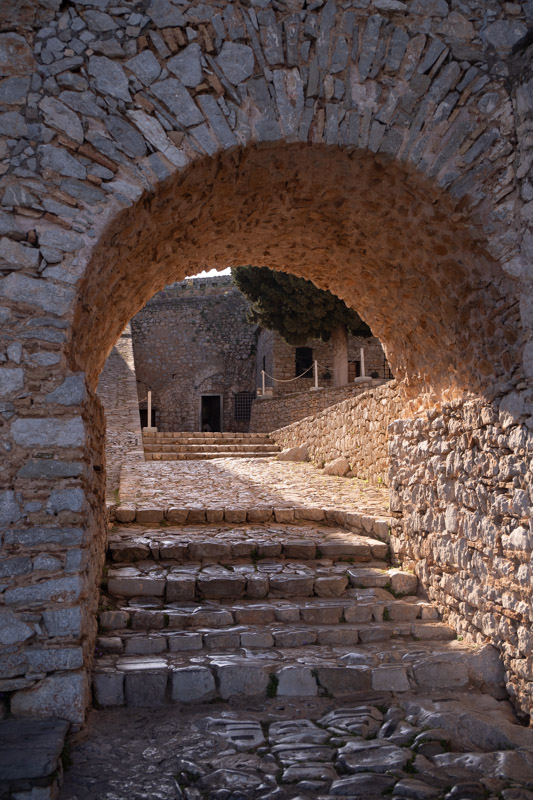
Once inside the fortress, you’ll find a labyrinthine network of walls, bastions, and interconnected buildings. These innovative defensive features for its time were built.
The fortifications include a series of eight self-contained bastions. This ensured that if one bastion was breached, the others could still be defended.
Each bastion has a water reservoir, ammunition and food storerooms, gunports, and moats murder holes, barracks and retaining walls when appropriate. The bastions are joined by a wall to protect from enemy fire.
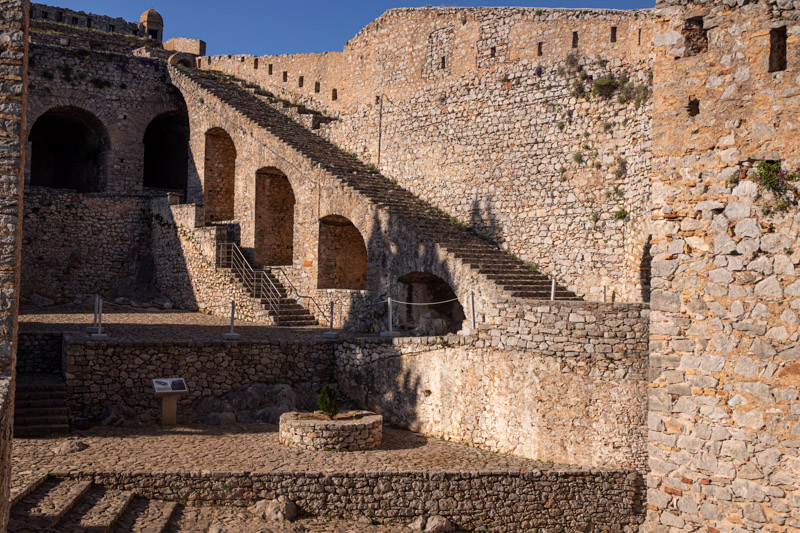
As you wander through the fortress, you’ll encounter narrow passageways made of worn stone, stairs, stone arches, and courtyards that add to its medieval ambiance.
Imagine the battles fought and the stories whispered within these ancient walls. It’s quite evocative and beautiful to walk round, equally matching the views at every fortress wall!
I was surprised at how well-preserved parts of the fortress are. Attendants are on hand to ask if you’re lost, like I had to do as I did not know how to get up to the higher bastions in the back of the fortress.

There is not a lot of useful information for you to read and learn. Some areas were roped off when I visited (they looked like great viewpoints!)
I’ve since discovered interesting areas of the fortress that I missed simply because I didn’t know what I was looking at. I will help you avoid that same mistake with this guide to Palamidi Castle.
Bastion of Robert
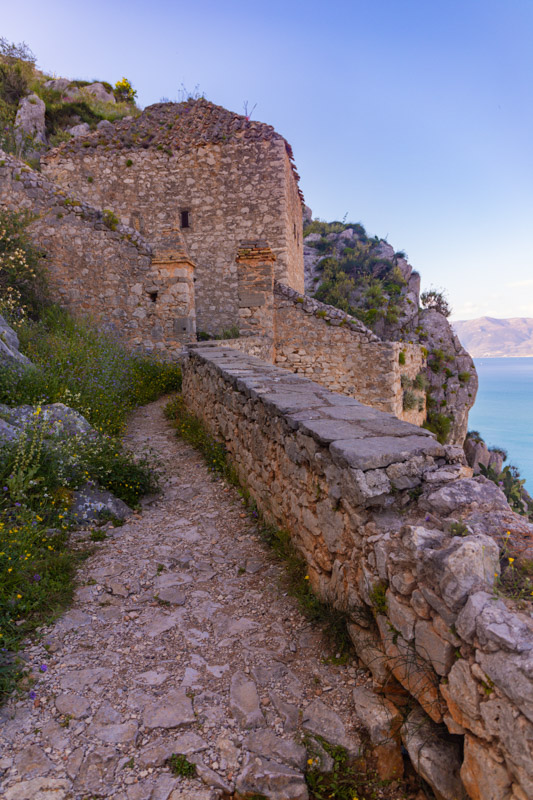
Almost to the top of the stairs, you’ll be rewarded with your first bastion view that will validate your decision to climb those stairs as being a good one.
The Bastion of Robert, which resembled a tower, by ascending took its name from the French Philhellene Robert, who fell gallantly in battle fighting on the Acropolis of Athens.
Nowadays its serene position on the edge of the cliff and fortress made it feel like a good spot for a morning coffee amongst the wildflowers growing wildly around it.
After the stairs you’ll pass through the western entrance gate, pay your low admission price of 8 euro and explore the fortress.
The Bastion of Agios Andreas
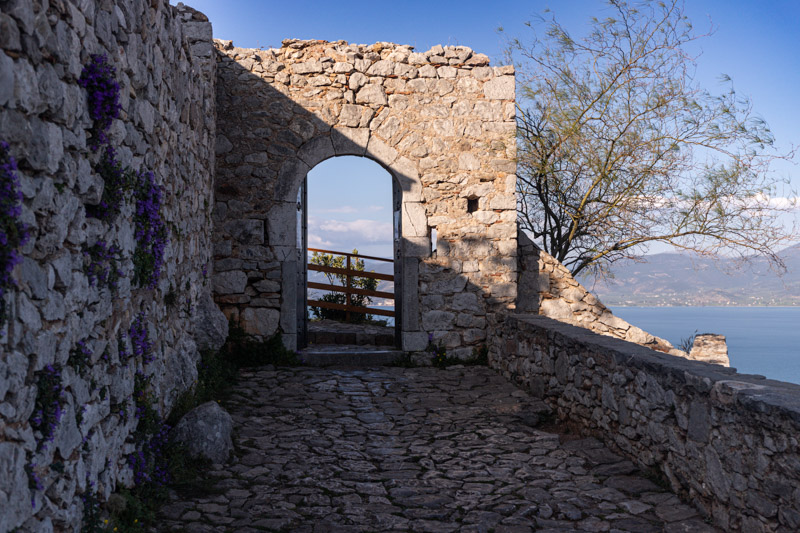
The large and imposing gate will take you to the most central, biggest, and strongest bastion, Agios Andreas, which is also quite well-preserved.
I don’t know how I did, but I missed one of the top attractions at Palamidi, the chapel of the Apostle Andreas. I was too focused on finding the dungeon near here.
The barrel-vaulted church is tucked away at the back of the courtyard. This was a small church whose eastern half lay beneath the rock, the Chapel of Agios Andreas.
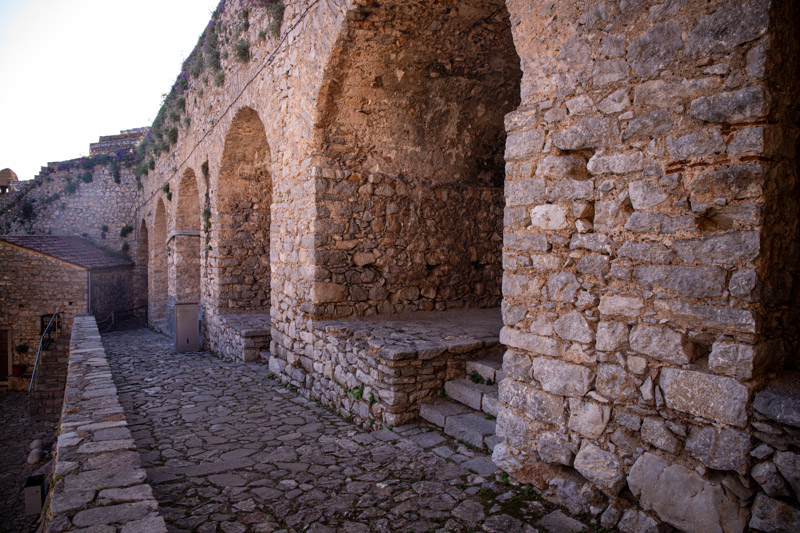
The chapel’s architecture and religious artifacts provide insight into the spiritual aspect of life within the fortress.
In the Greek War of Independence, the fortress was taken on the feast day of Agios Andreas (St Andrew), and so the Greeks dedicated the church to his memory.
A service of thanks and praise was held in the chapel when the fortress was taken over. From then on, every year on November 30, the day Nafplio became Greek, the liberation of the city is celebrated with a service in the historic chapel.
Prison Cell of Theodoros Kolokotronis
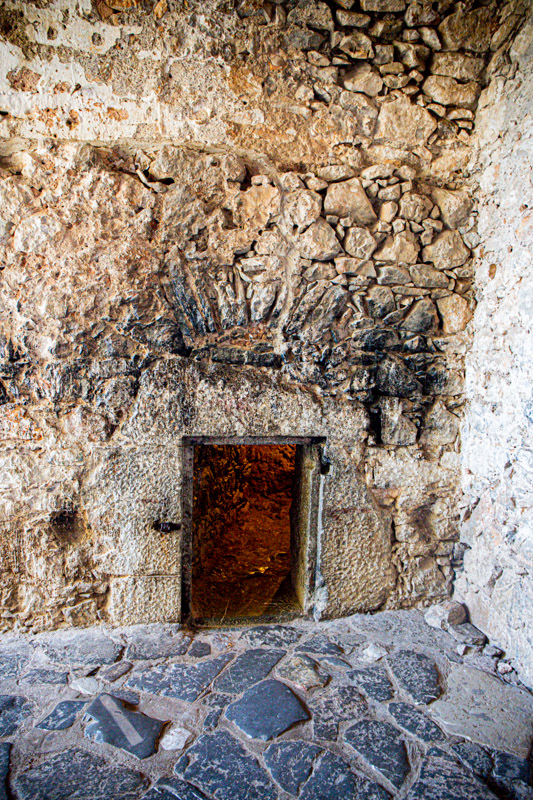
At the rear of the first arch near the church, there is a small entrance in the stone wall. Crouch down and crawl through to follow it, and you’ll find one of the most important monuments of the site.
This tiny damp and dark rectangular room is said to be the “Prison of Kolokotronis,” where was held for his crime of treason. It will be a fantastic reminder to follow the rules and stay out of trouble.
I’ve seen photos where the line to come into this prison was really long. At 8:30am I had this creepy hole in the wall all to myself!
Miltiades Bastion was used as a prison for condemned criminals serving life sentences. from 1840 to 1920.
Upper Fortresses
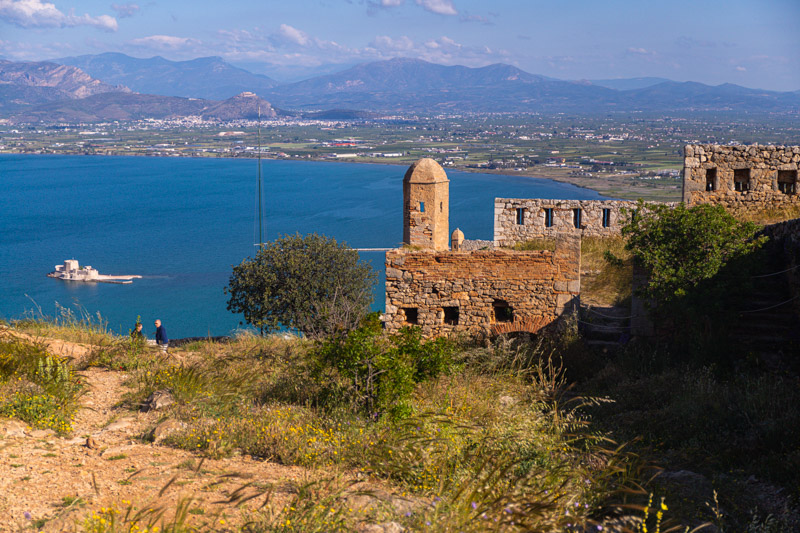
Heading up the back section you’ll encounter the bastions of the fortress with Ancient Greek names, such as The Bastion of Fokionos, Themistocles, and Bastion of Achilles.
These are not as well preserved and have uneven, rocky ground with overgrown weeds and wildflowers.
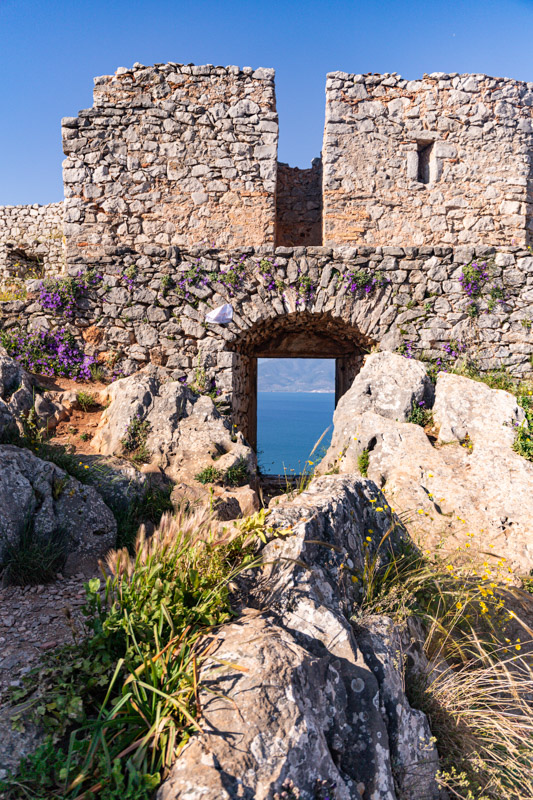
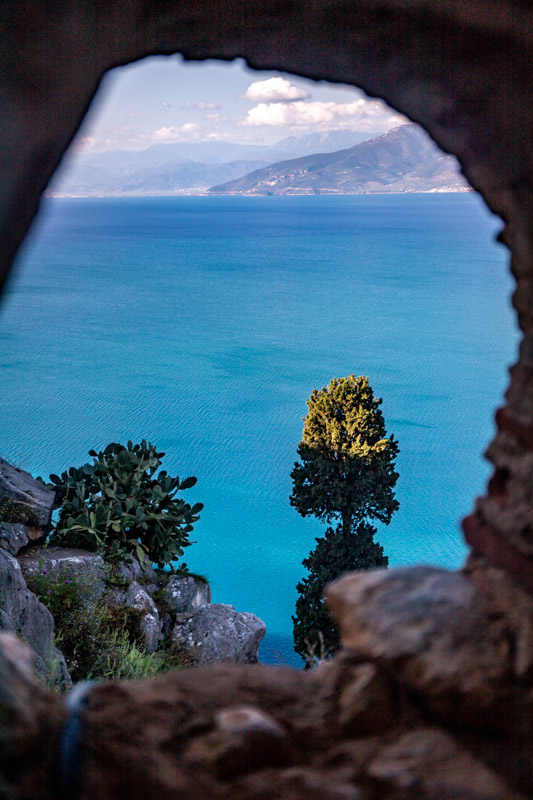
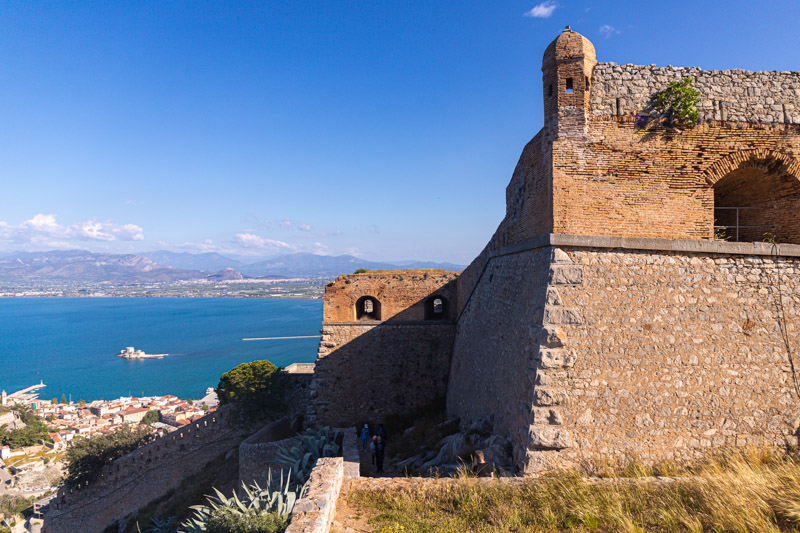
As they are higher up you have good vantage points for looking back on parts of Palamidi Castle and the rocky shoreline of Arvantias.
Look on the opposite side of the Argolic Gulf you’ll see other small fortresses perched on top of the hill. It definitely piqued my curiosity to explore more of this area of the Peloponnese.
Tips for an Enjoyable Visit to the Palamidi Castle
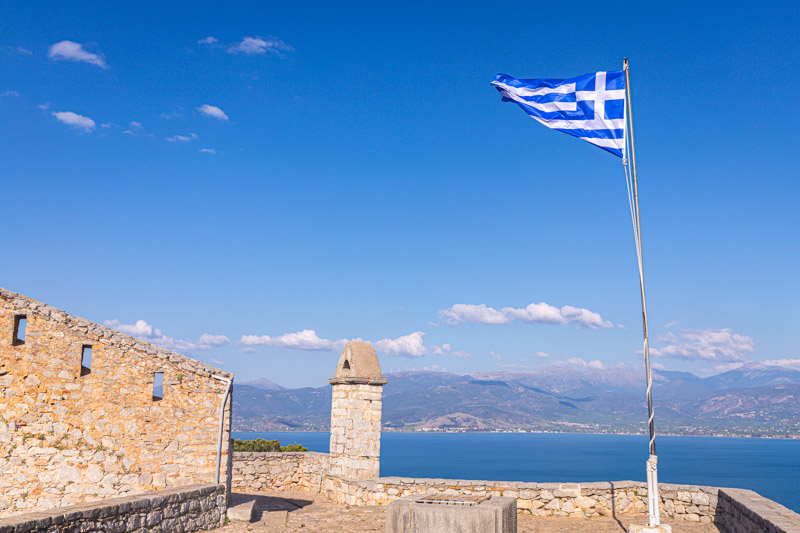
- Time your visit wisely: Aim to visit Palamidi Fortress either early in the morning or later in the afternoon to avoid the midday heat and crowds. The golden hour light adds an extra touch of magic to the experience.
- Note that there are different opening hours for wintertime and summertime. From October – April, the fort opens from 08:00am – 5:00pm, and May – September from 08:00am – 7.00pm.
- Stay hydrated: The climb may be strenuous for inexperienced hikers, so make sure to bring a water bottle to keep yourself hydrated along the way.
- Dress comfortably: Wear comfortable shoes and lightweight, breathable clothing to make your steep ascent more enjoyable.
- Capture the memories: Don’t forget to bring your camera or smartphone to capture the stunning views and unforgettable moments throughout your Palamidi adventure.
- There is no ramp or wheelchair access.
What to do after your climb to the Palamidi Fortress
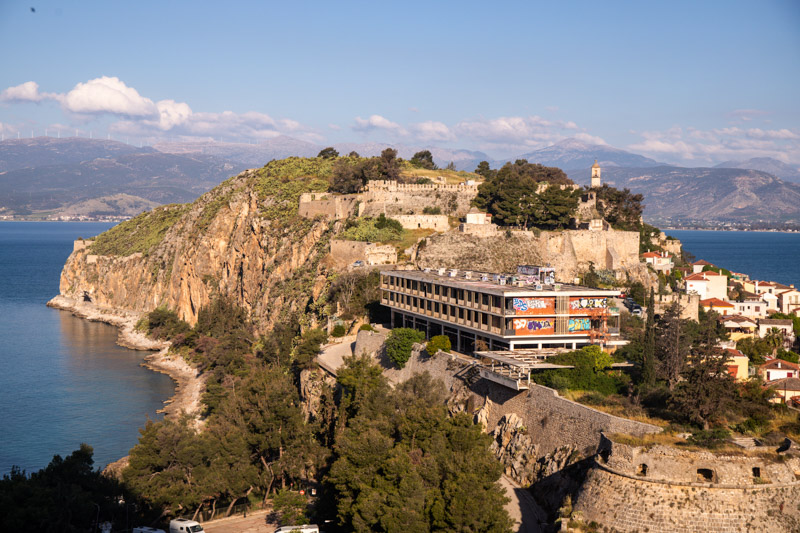
After conquering Palamidi, you have a few great options for things to do in the town of Nafplion. If you follow my advice and go early, you’ll have a lot more time on your hands.
You can combine the following suggestions into one loop walk – just follow the order as given.
- Take a short stroll to Arvanitia Beach, a charming pebble beach with crystal-clear waters. Relax, swim, and soak up the sun.
- From the beach you can walk the 1km Arvanitia Promenade as it hugs the coastline past Bourtzi Castle to Old Town Nafplion.
- Explore Old Town: explore the charming streets of Nafplio, indulge in local cuisine at the quaint tavernas, and soak up the laid-back vibe of this picturesque town. You may even want to do this walking tour of Nafplio.
- If you’re not too tired of fortresses, you can walk to the top of the hill at the edge of Old Town to see the Akronafplia Fortress, the oldest of Nafplio’s three castles and another one of Nafplio’s top archaeological sites. This one is mostly ruins, so not a lot to see but, again, beautiful views.
Where to Stay in Nafplio: Kapodistrias Hotel
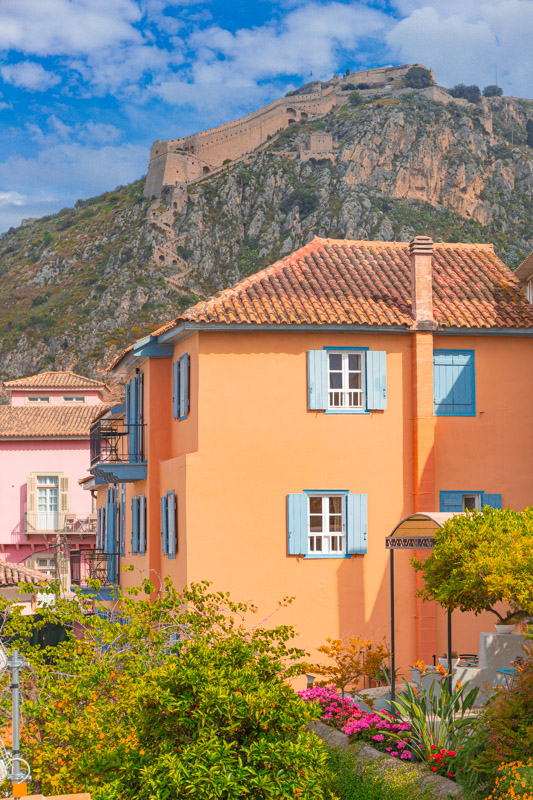
If you’re staying longer in Nafplio – and I highly recommend it, I can recommend the Kapodistrias Hotel in the Old Town. I stayed in the Nafplion room, which was tiny, but adequate since I was rarely there.
Thanks to the gorgeous views from my small balcony, easy access to walk to Nafplio attractions, and the price of sixty-five euro a night, I was very happy.
I couldn’t imagine staying anywhere but Old Town Nafplio. It’s far too charming to spoil the experience staying elsewhere. You can use the map below to find other options.
Final Thoughts on Visiting Palamidi Castle
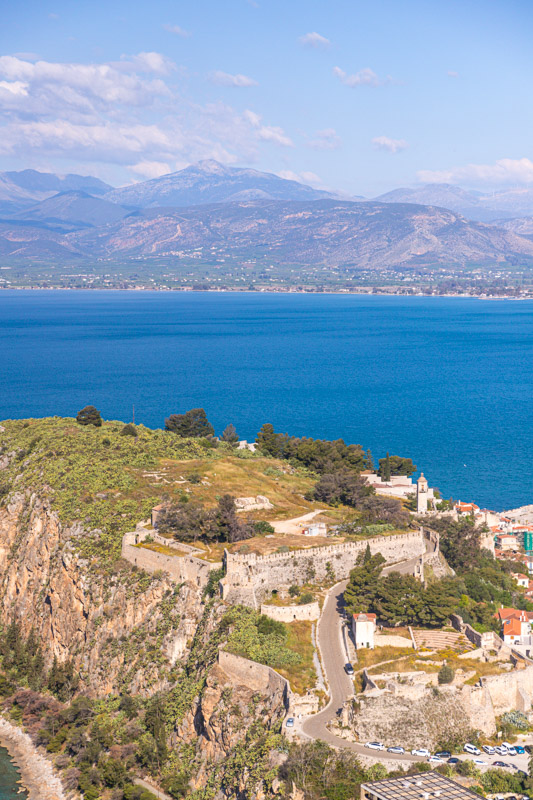
With its impressive architecture, historical significance, and picturesque location, the Palamidi Castle continues to be one of the most visited and revered landmarks in Greece.
It’s totally worth visiting the castle and climbing those steps to see it.
I found it a peaceful and rewarding experience, especially since I went early in the morning and almost had it to myself.
It’s a fantastic way to connect to the rich history of Nafplio and the Peloponnese, especially since the fortress played a pivotal role in Greece becoming its own nation – the one we all love to travel to now!
So, fellow explorers, are you ready to take on the heights of Palamidi Fortress in Nafplio? Let us know if you plan to visit this spectacular citadel and what you think of it!
[ad_2]
Source link
